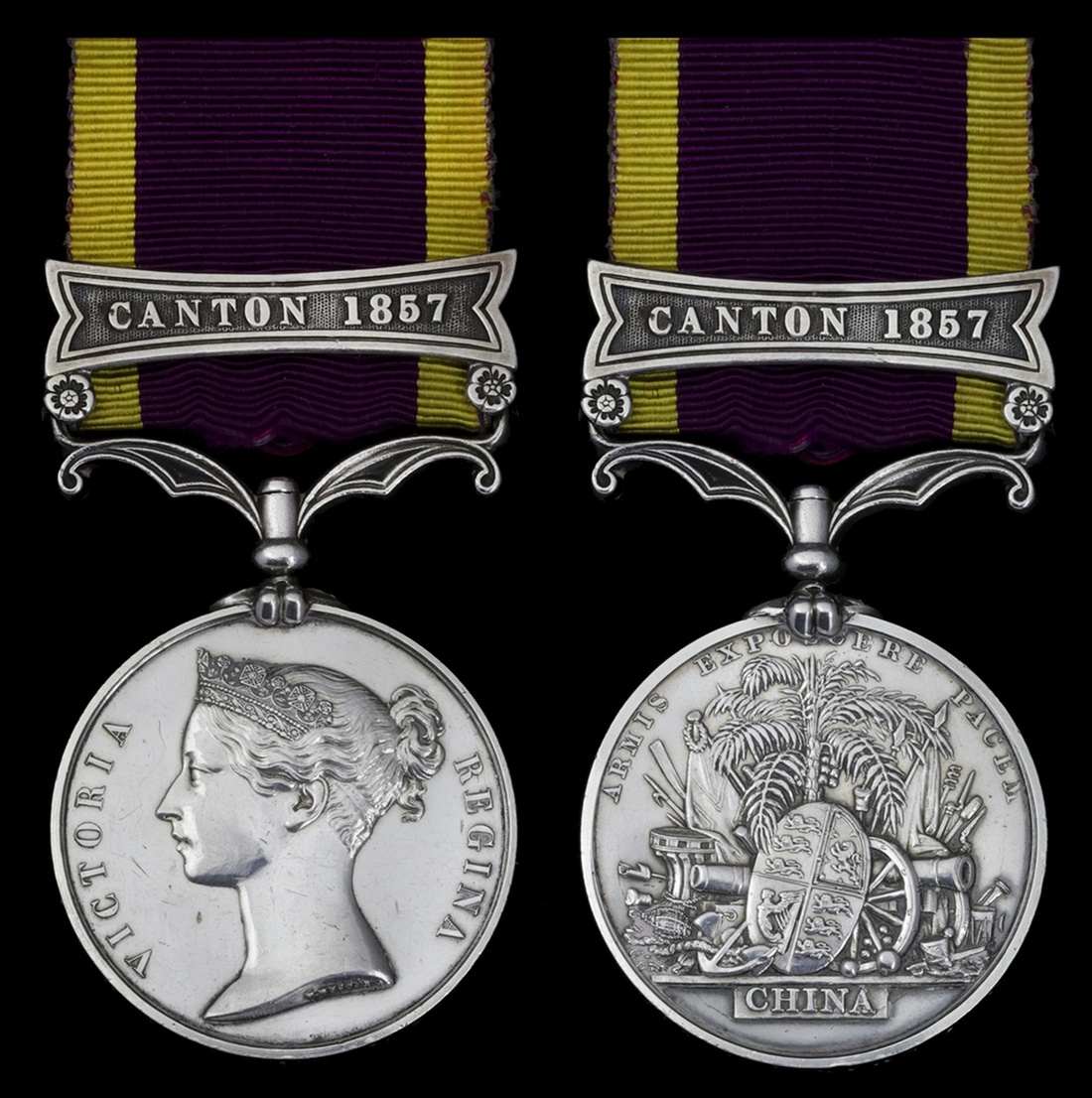
Auction: 19001 - Orders, Decorations and Medals
Lot: 116
The important China 1857-60 Medal awarded to Colonel Commandant W. J. Smart, Royal Engineers; assigned to the French Brigade during the assault on Canton on 29 December 1857, Stuart directed the scaling ladders and was reportedly the first man to reach the city's walls
China 1857-60, 1 clasp, Canton 1857 (Major W. J. Smart [sic.], Royal Engineers), officially impressed naming, light scratches to obverse, nearly extremely fine, with related miniature award, this lacking clasp
William James Stuart was born at Buncrana, Donegal in April 1831. Commissioned a 2nd Lieutenant in the Royal Engineers on 19 December 1849, he spent two years studying at the Royal Engineers Establishment, Chatham. On 26 September 1853 he joined the detachment of Royal Engineers bound for Hong Kong. Hong Kong had been acquired by Britain following victory in the First China War of 1842, the Royal Engineers working tirelessly to build its infrasture and defences. Stuart advanced to 1st Lieutenant on 17 February 1854. In October 1856, China infringed the Treaty of Nanking (1842) by capturing the cargo ship Arrow, which bore a British flag. This was Britain's official casus belli for the Second China War of 1857-60, also known as 'The Arrow War'. Unfortunately, troops destined for this theatre were diverted at Singapore in 1857 as news of the Indian Mutiny spread, leaving Hong Kong with a skeleton garrison. The Corps History of the Royal Engineers records:
'The force assembled during the year 1857 at Hong Kong was principally naval, and the only operations feasable were those that could be carried out by that branch of the service. The Royal Engineers at this time at Hong Kong were Colonel Lugard, Captain Mann, and Lieutenants Stuart, Dirom and Trench. Lieutenant Stuart had some time before been placed in command of a body of Volunteer Sappers, raised in Hong Kong, which he had succeeded in training to an extent that rendered them a very valuable auxiliary to our feeble Engineer strength. He, with a few of this company, was attached to the French Brigade, under the command of Admiral de Genouilly, and served with it throughout the operations.'
Stuart took part in the attack on Canton on 28 December 1857. British and French ships bombarded the city from the Canton river, drawing the defenders' fire while the army disembarked. The Royal Engineers worked through the night building roads and jetties to supply the Allied force. The next day, Stuart led the French Brigade's storming party. In his subsequent report of the action, dated 3 January 1858, he recalled:
'I proceeded to make a reconnaissance of the proposed point of attack, from the most advanced French post. As the sappers carried their tools with them, I at once set them to work to clear a passage for the ladders. I found that the stream from the city wall, by being arched over, offered a height of ascent less by three or four feet than the adjoining proportions. I deemed this such a suitable point for escalade that I reported its nature, at once, to the French officers. The two parties assaulted about the same time. The party on the right, with which I entered, pursued the flying Chinese. We advanced together to the "Great North Gate," taking possession on our way of "Little North Gate," "5-storied Pagoda" and "Magazine Hill."'
George Cooke, The Times' special correspondent in China, mentioned Stuart in his report on the assault:
'Stuart of the Engineers was balancing in air upon a breaking ladder at the north side of the bastion.'
Admiral de Genouilly praised Stuart in his despatch to General Straubenzee, recommending him for the Legion of Honour. Captain G. F. Mann, commanding the Royal Engineers, confirmed in his despatch dated 13 January 1858 that Stuart was:
'the first to escalade the walls as guide to the French attack.'
Following the capture of Canton, Stuart was employed in demolishing a series of forts which posed a risk to the garrison, describing their destruction in minute detail. He returned to England on 29 November 1858, and was posted to the War Office for two years. On 16 October 1861 he took up the appointment of Instructor of Fortification at the Royal Military Academy, Woolwich, becoming Professor of Fortification by the end of his tenure. On 12 December 1876 he returned to the Orient aboard the troopship Himalaya, serving as Commanding Royal Engineer in Hong Kong and China. Returning to England in 1880, he became Commanding Royal Engineer at Weymouth, 3 June 1880; Chatham, 31 December 1881; and Woolwich, 8 July 1885. He was promoted to Major-General on 12 February 1888 and Colonel Commandant of the Royal Engineers on 9 August 1903.
Stuart married Miss Eleanor Dorkas French in 1859, fathering four sons. He died in July 1914; sold with copied research.
Subject to 20% VAT on Buyer’s Premium. For more information please view Terms and Conditions for Buyers.
Sold for
£600




